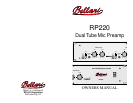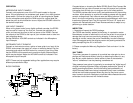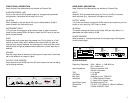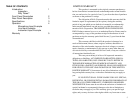
Congratulations on choosing the Bellari RP220 Studio Tube Preamp. We
recommend that you take a moment and read this manual as it provides
information that will help you in using your unit to it's fullest potential.
The RP220 provides clear sonic quality and performance for the working
musician, studio operator or anyone who needs a preamp with the warm,
smooth, analog sound. Each channel uses one Bellari premium 7025
tube in a unique configuration to give smooth controllable gain with a true
transformer balanced input. The unit has both XLR and 1/4" inputs and
outputs with Pad switches and Phase Reverse switches to adapt to any
performing or studio situation.
INSPECTON
1. Unpack and Inspect the RP220 package
Your RP220 was carefully packed at the factory in a protective carton.
Nonetheless, be sure to examine the unit and the carton for any signs of
damage that may have occurred during shipping. If obvious physical
damage is noticed, contact the carrier immediately to make a damage
claim. We suggest saving the shipping carton and packing materials for
safely transporting the unit in the future.
2. Please complete the Warranty Registration Card and return it to the
factory.
WHY TUBES
The primary purpose of a preamp is to provide low noise gain to micro-
phones and instruments without coloring or distorting the sound in any
way. But any audio electronic device seems to have a characteristic
"sound," sometimes it can be pleasing, sometimes not.
Tube preamps have gained in popularity to counteract the "digital sound"
of digital recording equipment. Many engineers preferred the "sound" of
analog recording equipment, but like the editing and predictability of
digital. Because tubes have natural compression they have a smoother
sound than solid state preamps. When they do clip, they have a more
even harmonic structure. Attempts to duplicate these characteristics with
solid state circuits have met with limited success.
OPERATION
MICROPHONE INPUT EXAMPLE
Connect a microphone to one of the XLR inputs located on the rear
panel. If the microphone is a condenser type, press in the +48V phantom
power switch. Connect the output to a mixer or recording device. Speak
into the microphone and adjust the GAIN control for a signal level just
below the point at which distortion occurs. Adjust the VOLUME control for
the desired output level.
LINE INPUT EXAMPLE
When mixing down tracks from a digital multitrack recorder, the RP220
may be used to "warm-up" the final mix. Connect the multitrack to a
mixer, and connect the mixer to the line inputs on the RP220. Connect
the outputs of the RP220 to the input of your mixdown deck or other two-
track recording device.
Set the GAIN and VOLUME controls as indicated in the Microphone
Input Example.
INSTRUMENT INPUT EXAMPLE
Connect an instrument such as a guitar or bass guitar to an input of the
RP220, and connect the output to a mixer or recording device. Play the
instrument and adjust the GAIN control for a sound to your liking. Note
that the RP220 can be overdriven to provide a slightly distorted signal,
which may be desired. Adjust the VOLUME control as indicated in the
Microphone Input Example.
NOTE: These are just suggested settings. Your applications may require
different procedures for setup.
BLOCK DIAGRAM
14
OUTPUT
LEVEL
INPUT
OUTPUT
250V
2
2
+48 VOLT
PHANTOM POWER
PHASE
REVERSE
250V
GAIN
Power Supply
+12
-12
+250
+48
Output
Buffer
30dB PAD
20
10
5
3
0
3
6
dB
30dB
PAD
SWITCH






